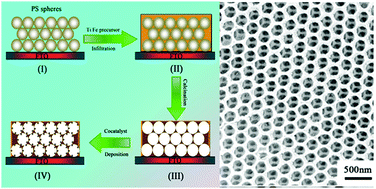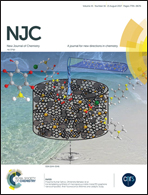Light absorption modulation of novel Fe2TiO5 inverse opals for photoelectrochemical water splitting†
Abstract
TiO2 and Fe2O3 are the most promising anode materials for the assembly of photoelectrochemical devices. However, their intrinsic poor light absorption (TiO2) and poor electrical conductivity (Fe2O3) seriously limit their industrial feasibility. Thus, it is of great importance to develop novel Fe–Ti–O systems which can combine the characteristics of high charge mobility, long carrier lifetime and visible light-driven activity. In this paper, novel Fe2TiO5 inverse opals with modulated light absorption were prepared using polystyrene (PS) photonic crystals as templates. The maximum overlap between the stop-bands and the absorption edges was found to be beneficial for the multiple scattering of visible light. Due to the enhanced light absorption and superior charge separation, inverse opals fabricated using 250 nm PS spheres exhibited higher photocurrent density than Fe2O3, TiO2 and disordered Fe2TiO5 film. The performance of the photoanodes could be further improved by the deposition of FeOOH as a cocatalyst. This work provides a principal method for the development of novel photoanodes with modulated microstructures for efficient photoelectrochemical applications.



 Please wait while we load your content...
Please wait while we load your content...